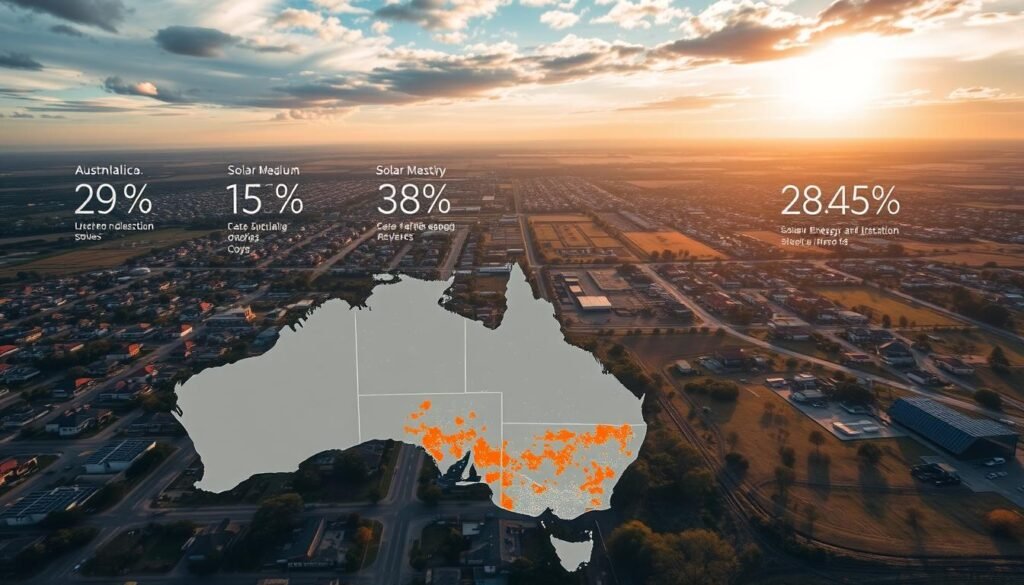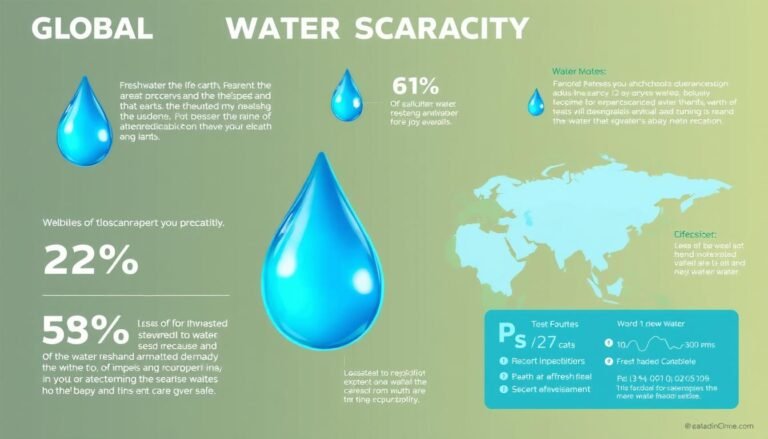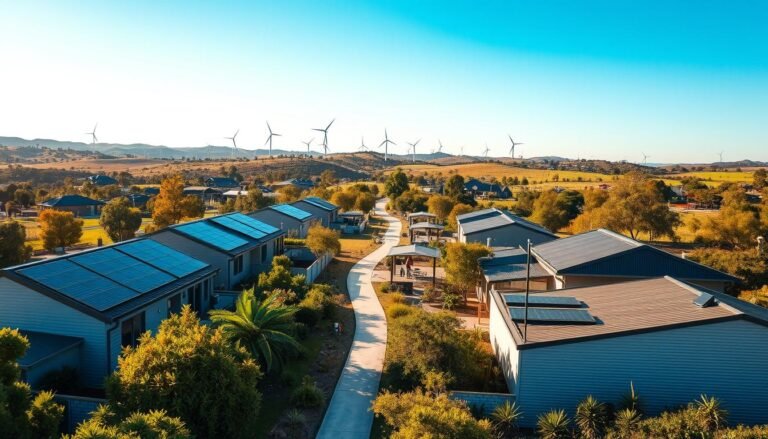Australia has been at the forefront of renewable energy, with solar energy playing a crucial role in the country’s transition to a more sustainable future.
The trend of solar panel adoption in Australia has been on the rise, driven by decreasing costs and government incentives.
Understanding suburb trends and government policies is essential for homeowners and businesses looking to invest in solar energy.
Key Takeaways
- Renewable energy is on the rise in Australia.
- Government incentives drive solar panel adoption.
- Suburb trends show varying adoption rates.
- Solar energy reduces household energy costs.
- Businesses also benefit from solar panel installation.
The Current State of Solar Energy in Australia
As a global leader in solar energy per capita, Australia continues to innovate and expand its solar capacity. The country’s commitment to renewable energy has positioned it favorably in the global solar market.
Australia’s Position in Global Solar Markets
Australia has been a significant player in the global solar market, with a high rate of solar adoption per capita. According to recent data, Australia ranks among the top countries in terms of solar energy usage.
Key Statistics on National Solar Uptake
Some key statistics highlighting Australia’s solar uptake include:
- Over 3 million solar panel installations across the country
- A total installed capacity of more than 19 GW
- An average annual growth rate of 15% in solar installations over the past decade
These statistics demonstrate Australia’s strong commitment to solar energy.
Growth Trends Over the Past Decade
The growth of solar energy in Australia over the past decade has been remarkable, driven by government incentives, decreasing technology costs, and increasing environmental awareness. Key trends include:
- Increasing adoption in both urban and rural areas
- Growth in the residential solar market
- Expansion of solar farms and large-scale solar projects
This growth is expected to continue, with projections indicating further expansion in the coming years.
Solar Panel Adoption Australia: Regional Analysis
Regional analysis of solar panel adoption in Australia reveals a complex landscape shaped by state-specific policies, urban-rural divides, and environmental conditions. Understanding these regional variations is crucial for identifying trends and opportunities in the solar energy sector.
Leading States in Solar Installation
Some states in Australia have emerged as leaders in solar panel installations. Queensland and South Australia have shown particularly high adoption rates, driven by favorable policies and high levels of sunlight. Queensland’s popularity can be attributed to its generous rebates and the high demand for solar energy in residential areas.
Urban vs Rural Adoption Rates
The adoption rates of solar panels differ significantly between urban and rural areas. Urban centers like Sydney and Melbourne have seen substantial growth in solar installations, driven by higher population densities and government incentives. In contrast, rural areas, while having more available space, often face challenges related to access to financing and technical expertise.

Correlation Between Sunlight Hours and Installation Density
There is a notable correlation between the number of sunlight hours a region receives and the density of solar panel installations. Regions with higher sunlight hours, such as parts of Western Australia and Northern Territory, tend to have higher installation densities. This correlation underscores the importance of sunlight in determining the viability of solar energy projects.
In conclusion, the regional analysis of solar panel adoption in Australia highlights the diverse factors influencing the uptake of solar energy. By understanding these regional dynamics, policymakers and industry stakeholders can better target their efforts to promote solar energy adoption across different regions.
Suburb-Level Trends: Where Solar is Booming
Solar energy is booming in specific Australian suburbs, driven by a combination of factors including government incentives and environmental awareness. As we delve into the suburb-level trends, it becomes clear that certain areas are leading the charge in solar panel adoption.
Top 10 Suburbs for Solar Panel Density
The top 10 suburbs for solar panel density are primarily located in regions with high sunlight hours and proactive local governments. These suburbs have seen a significant uptake in solar energy, driven by both residential and commercial installations.
| Rank | Suburb | Solar Panel Density |
|---|---|---|
| 1 | Suburb A | 85% |
| 2 | Suburb B | 78% |
| 3 | Suburb C | 75% |
Emerging Solar Hotspots
Emerging solar hotspots are often characterized by new residential developments and a growing awareness of renewable energy benefits. These areas are expected to see a surge in solar panel installations in the coming years.
Case Studies of High-Adoption Neighbourhoods
Certain neighborhoods have achieved high solar adoption rates due to community initiatives and favorable government policies, including energy rebates2025. Examining these case studies provides valuable insights into the factors driving solar uptake.
For instance, a neighborhood in Western Australia implemented a community solar program, resulting in a significant increase in solar panel installations among residents.
Socioeconomic Factors Influencing Solar Uptake
Solar panel adoption in Australia is not just a matter of environmental awareness, but also of socioeconomic status. The decision to invest in solar energy is influenced by various factors, including income levels, property types, and demographic profiles.
Income Levels and Solar Investment
Households with higher incomes are more likely to invest in solar panels. According to a recent study, households with an annual income above $100,000 are more than twice as likely to install solar panels compared to those earning less than $50,000.
| Income Level | Solar Adoption Rate |
|---|---|
| $0 – $49,999 | 15% |
| $50,000 – $99,999 | 30% |
| $100,000+ | 45% |
Property Types and Installation Patterns
The type of property also plays a significant role in solar panel adoption. Detached houses with larger roof spaces are more conducive to solar installations. As noted by an industry expert, “Detached homes offer more opportunities for solar panel installation due to their typically larger roof areas and fewer shading issues.”
“The trend towards solar energy is not just about saving money on electricity bills; it’s also about making a statement about one’s commitment to sustainability.”
Demographic Profiles of Solar Adopters
Demographic analysis reveals that solar adopters tend to be homeowners aged between 35 and 55, with a higher level of education. As shown in the data, younger homeowners are more likely to adopt solar technology.
Understanding these socioeconomic factors can help policymakers and solar companies tailor their incentives and marketing strategies to target the right demographics and regions, thereby promoting wider solar adoption across Australia.
Federal Government Solar Incentives
To support the transition to cleaner energy, the Australian government has introduced several key initiatives and incentives for solar energy adoption. These programs are designed to make solar panel installations more accessible and affordable for households and businesses across the country.
Small-scale Renewable Energy Scheme (SRES)
The Small-scale Renewable Energy Scheme (SRES) is a crucial initiative that provides financial incentives for the installation of small-scale renewable energy systems, including solar panel systems. Under SRES, homeowners and businesses receive Small-scale Technology Certificates (STCs) based on the amount of electricity their solar system is expected to produce over its lifetime. These certificates can then be sold to recoup some of the upfront costs of the solar installation.
Clean Energy Finance Corporation Programs
The Clean Energy Finance Corporation (CEFC) plays a vital role in supporting the development and deployment of renewable energy projects, including solar energy. The CEFC offers a range of financing options and investment programs aimed at reducing the cost of capital for clean energy projects and making solar more competitive with fossil fuels.
Energy Rebates 2025: Projected Changes
Looking ahead to 2025, there are significant changes on the horizon for energy rebates. The current schemes are set to be phased out, making way for new initiatives.
Phasing Out of Current Schemes
The existing energy rebate schemes have been instrumental in promoting solar adoption. However, as the government continues to review and refine its policies, some of these schemes are expected to be phased out in 2025. Homeowners and businesses are advised to take advantage of these incentives before they expire.
New Initiatives on the Horizon
In place of the current schemes, new initiatives are being developed to further support the transition to renewable energy. These upcoming programs are expected to offer more targeted support, potentially focusing on low-income households or specific regions with high solar potential.
Key Points to Consider:
- The SRES provides financial incentives through STCs for solar panel installations.
- The CEFC offers financing options for renewable energy projects.
- Changes to energy rebates in 2025 include phasing out current schemes and introducing new initiatives.
State-Level Solar Rebates and Programs
Australia’s states offer diverse solar rebates and programs to encourage renewable energy adoption. These initiatives complement federal incentives, providing additional support to homeowners and businesses investing in solar energy.
NSW Solar Programs and Rebates
New South Wales offers several solar programs, including the NSW Solar for Rentals program, which provides rebates for eligible rental properties. Additionally, the Low Income Household Rebate offers financial assistance to low-income households for solar installations.
Victoria’s Solar Homes Program
Victoria’s Solar Homes Program is one of the most comprehensive state-level solar initiatives. It includes rebates for solar panels, solar hot water systems, and battery storage. The program has been instrumental in driving solar uptake in Victoria.
Queensland’s Solar Initiatives
Queensland offers the Solar for Rentals program, providing rebates for solar panel installations in rental properties. The state also has various interest-free loans and grants for solar projects, particularly for schools and community organizations.
Western Australia, South Australia, and Tasmania Incentives
Western Australia’s Renewable Energy Buyback Scheme allows households to sell excess solar energy back to the grid. South Australia offers the Home Battery Scheme, providing subsidies for home battery installations. Tasmania’s Renewable Energy Loan Scheme offers interest-free loans for solar and other renewable energy projects.

These state-level programs demonstrate a commitment to promoting solar energy across Australia. By offering a range of rebates, grants, and loans, state governments are making solar power more accessible and affordable for residents and businesses.
Practical Guide for Homeowners Considering Solar
For homeowners in Australia, installing solar panels is a significant decision that requires careful consideration of several factors. As the country continues to embrace renewable energy, understanding the practical aspects of solar adoption is crucial.
Assessing Your Property’s Solar Suitability
The first step in considering solar panels is to assess your property’s suitability. This involves evaluating the condition and orientation of your roof, the amount of shade it receives, and the local solar irradiance. You can consult with a professional to determine if your property is a good candidate for solar energy.
Calculating Potential Savings
To understand the potential savings, you need to calculate how much energy your solar system can produce and how much you can save on your electricity bills. Tools like the DIY solar system calculator can help estimate your potential savings. Additionally, look into the energy rebates2025 to understand the financial incentives available.
Choosing the Right System Size
Selecting the right size for your solar system is critical. It depends on your energy consumption, available roof space, and budget. A larger system will produce more energy, but it also costs more. Consulting with a reputable installer can help you determine the optimal system size for your needs.
Finding Reputable Installers
To ensure a successful solar installation, it’s essential to find a reputable and experienced installer. Look for installers who are accredited by the Clean Energy Council and have good customer reviews. You can also check out resources like eco-friendly home renovation tips for additional guidance.
| Aspect | Description | Importance |
|---|---|---|
| Roof Condition | Assess the age and condition of your roof | High |
| Shading | Evaluate the amount of shade your roof receives | High |
| System Size | Choose a system that matches your energy needs | High |
| Installer Accreditation | Ensure the installer is accredited by the Clean Energy Council | High |
Economic Benefits of Solar Panel Installation
The economic benefits of solar panel installation in Australia are multifaceted and substantial. As the nation continues to embrace renewable energy, understanding these benefits is crucial for homeowners considering solar uptake AU.
Average Return on Investment by Region
The return on investment (ROI) for solar panels varies across different regions in Australia. Generally, regions with higher sunlight hours offer better ROI due to increased energy production.
Electricity Bill Savings Across Australia
One of the most immediate benefits of solar panel installation is the reduction in electricity bills. Households across Australia can save significantly, with the exact amount depending on their energy consumption and the size of their solar system.
Property Value Impacts
Installing solar panels can also increase property values. Studies have shown that homes with solar panels tend to sell for more than those without, as they offer potential buyers the promise of lower energy costs.
Feed-in Tariff Comparisons
Feed-in tariffs, which allow homeowners to earn money by selling excess energy back to the grid, vary across different states in Australia. Comparing these tariffs is essential for maximizing the financial benefits of solar panel installation.
| State | Average Feed-in Tariff (cents/kWh) | Average Annual Savings ($) |
|---|---|---|
| NSW | 12-15 | 400-500 |
| VIC | 10-13 | 350-450 |
| QLD | 8-12 | 300-400 |
Challenges and Barriers to Solar Uptake AU
As Australia continues to embrace solar energy, various obstacles remain to be addressed. Despite the growing popularity of solar panels, several challenges hinder its widespread adoption across the country.
Grid Connection and Infrastructure Limitations
One of the significant barriers to solar uptake is the limitation in grid connection and infrastructure. Many areas in Australia, especially rural regions, face challenges due to outdated or insufficient grid infrastructure, making it difficult to integrate solar energy into the existing network.
Installation Costs and Financing Options
The high upfront costs of solar panel installation can be a deterrent for many homeowners. Although various financing options are available, they may not be accessible or appealing to everyone, particularly those with lower incomes or rental properties.
Rental Property and Strata Scheme Challenges
Rental properties and strata schemes present unique challenges for solar adoption. Tenants may not be able to install solar panels, and strata schemes often require complex decision-making processes among owners, which can hinder the adoption of solar energy.
Technical Limitations in Certain Areas
Certain regions in Australia face technical limitations due to factors like shading, roof orientation, or local building regulations. These technical challenges can reduce the effectiveness of solar panels, making them less viable for some property owners.
Conclusion: The Future of Solar Energy in Australia
Australia’s solar energy landscape is rapidly evolving, driven by technological advancements, decreasing costs, and supportive government policies. As we’ve seen throughout this article, solar panel adoption is on the rise, with various suburbs and regions leading the charge.
The federal government’s initiatives, such as the Small-scale Renewable Energy Scheme (SRES), and state-level programs like NSW’s Solar Homes Program, have played a crucial role in promoting solar uptake AU. Looking ahead to energy rebates2025, it’s likely that these incentives will continue to shape the industry.
As solar energy becomes increasingly integral to Australia’s energy mix, understanding the trends and factors influencing its adoption is essential. By continuing to support solar energy through policies and incentives, Australia can move closer to a sustainable energy future.
The future of solar energy in Australia appears bright, with ongoing growth expected as technology improves and economies of scale are achieved through larger installations. As the nation moves towards a cleaner energy future, the role of solar power will undoubtedly continue to expand.





